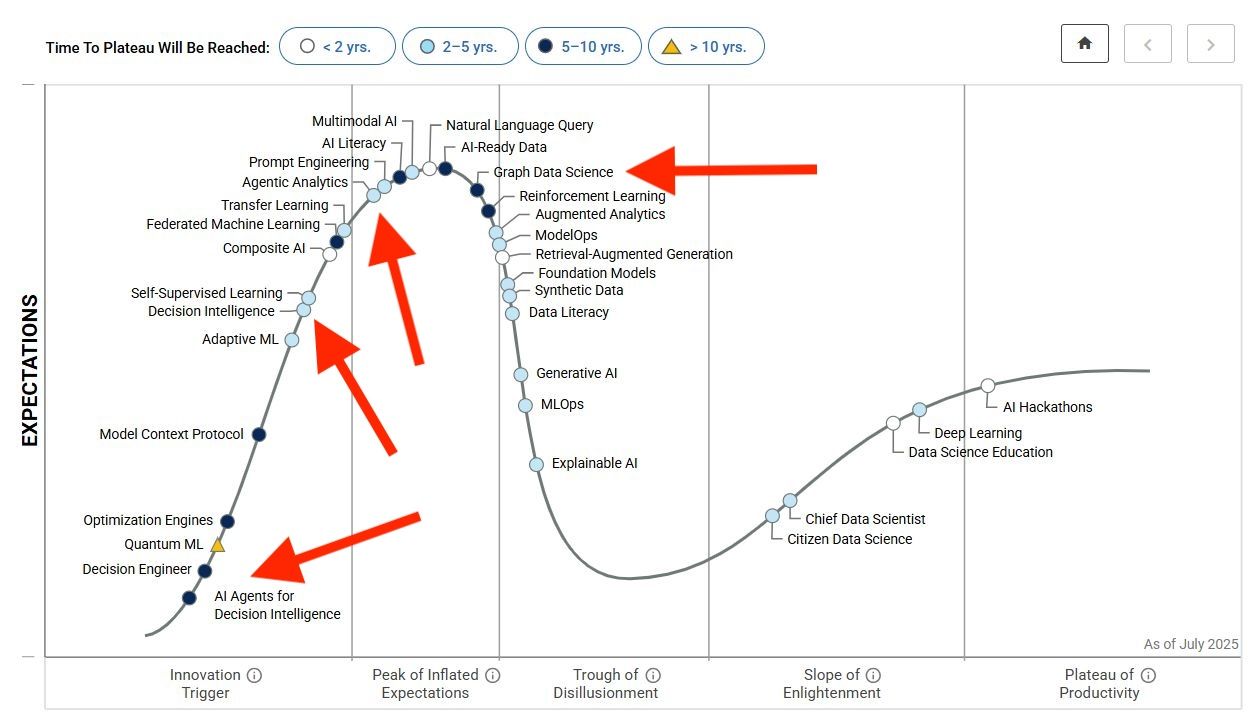By clicking “Accept”, you accept that cookies will be stored on your device to improve site navigation, analyze site usage and assist in our marketing efforts. Consult our Cookie Policy for more information.

Every summer, the AI Hype Cycle reignites the debate. By 2026, you should look at the Pieces that are laying the groundwork of how companies will decide. It's not another list: it's a architectural plan to go from “nice reports” to decisions connected with the result.
These are the five technologies that, together, make up the puzzle at the start of the curve.

For years we have invested in BI to describe the past. The next jump is operationalize the decision: systems that Recommend the best action according to objectives, restrictions and risk.
Analytics ceases to be a destination and becomes interactive and proactive. Los analytical agents they understand intent, they consult multiple sources, Explain results and They push insights when they detect relevant changes.
Beyond insight, these agents execute tasks, Evaluate results and Adjust decision policies on an ongoing basis.

He is not a classic data scientist or an analyst. It's who Design the reasoning system: defines objectives, restrictions, signs, sources of truth and How do you close the loop between action and result.
The real company are relationships: customers with products, suppliers with risks, teams with projects. Los Graphs they capture that network and allow Reason about the context, something that tables can't do.
Put these ideas into practice with applied, business-oriented training. Choose your route: Master in Artificial Intelligence, Master in Data Governance or Master in Connected Industry and Artificial Intelligence. Request Information Today and accelerate your career in business intelligence architecture.
Every summer, the AI Hype Cycle reignites the debate. By 2026, you should look at the Pieces that are laying the groundwork of how companies will decide. It's not another list: it's a architectural plan to go from “nice reports” to decisions connected with the result.
These are the five technologies that, together, make up the puzzle at the start of the curve.

For years we have invested in BI to describe the past. The next jump is operationalize the decision: systems that Recommend the best action according to objectives, restrictions and risk.
Analytics ceases to be a destination and becomes interactive and proactive. Los analytical agents they understand intent, they consult multiple sources, Explain results and They push insights when they detect relevant changes.
Beyond insight, these agents execute tasks, Evaluate results and Adjust decision policies on an ongoing basis.

He is not a classic data scientist or an analyst. It's who Design the reasoning system: defines objectives, restrictions, signs, sources of truth and How do you close the loop between action and result.
The real company are relationships: customers with products, suppliers with risks, teams with projects. Los Graphs they capture that network and allow Reason about the context, something that tables can't do.
Put these ideas into practice with applied, business-oriented training. Choose your route: Master in Artificial Intelligence, Master in Data Governance or Master in Connected Industry and Artificial Intelligence. Request Information Today and accelerate your career in business intelligence architecture.
Have you been interested? Go much deeper and turn your career around. Industry professionals and an incredible community are waiting for you.